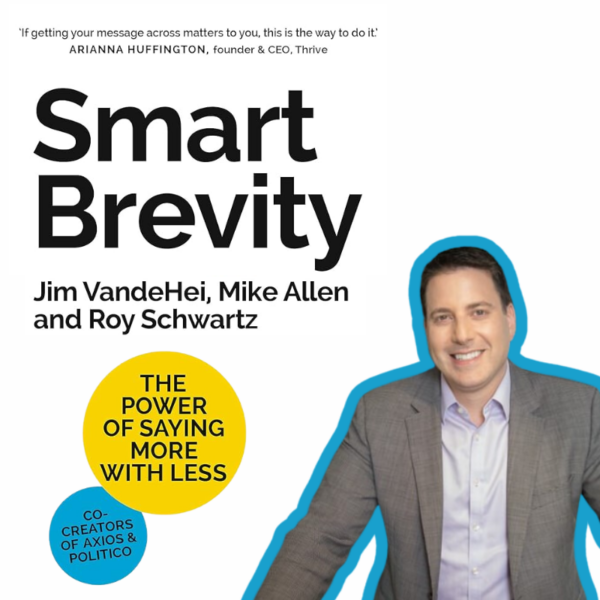
Smart Brevity: The Art of Saying More with Less
In today's attention-starved business environment, the ability to communicate clearly and concisely can make or break a CMO's success. Roy Schwartz, co-founder of Axios and Axios HQ and co-author of Smart Brevity, joined a CMO Huddles Career Huddle to share powerful insights into transforming corporate communication. His techniques, once used to revolutionize digital news delivery at Axios, are now helping marketing leaders cut through the noise and drive meaningful engagement.
Schwartz highlighted the importance of audience-first thinking, the surprising power of personality in corporate communications, and how smart brevity directly connects to pipeline and revenue. His practical strategies, drawn from years of media innovation, provide a roadmap for CMOs to create more impactful communications and lead with clarity.
To help marketing leaders master smart brevity, Schwartz outlined these essential principles:
1. Write for an Audience of One
"Put up a picture or an image of the person you're trying to reach. It'll make all your communication better, because you'll be talking to a person as opposed to corporate speak."
Rather than writing for a generic persona, Schwartz advocates visualizing a specific individual. This approach naturally eliminates corporate jargon and creates more engaging, relatable content. For CMOs crafting communications, whether internal updates or external messaging, this simple shift can dramatically improve engagement and understanding.
2. Focus on "What's New" and "Why It Matters"
"Keep your content focused on what they need to know: The 'What's New' and the 'Why it Matters.' The moment you do that, it will change the way you communicate for the better."
This two-part framework forces writers to prioritize information and justify its relevance. Instead of burying the lead, start with what's changing and immediately explain its impact. This approach not only respects readers' time but also ensures your message resonates with its intended audience.
3. Embrace the Power of Internal Communications
"We advise all our clients to have once-a-week, all hands updates that go out to the entire staff. The person who writes it must have their personality come through."
Regular, personality-driven internal communications can transform company culture and alignment. CMOs can take the lead by implementing weekly department updates that showcase both results and character. This approach not only improves information flow but can position marketing leaders as internal thought leaders and culture carriers. Readers connect more with authentic communication so don’t be afraid to inject your personality into your writing.
4. Talk Before You Type
"When we write, even when we dictate, we sound different. We get into corporate speak, we start using language that you would never use when you're just having a conversation."
Schwartz recommends talking through your ideas first, as if having a conversation with your intended audience. This practice helps eliminate unnecessary jargon and creates more natural, engaging content. Record yourself explaining the concept, then use that as a foundation for your written communication. If you wouldn't say it in conversation, don't write it in an email.
5. Use White Space Strategically
"When you look at eye-tracking studies and any research on how humans absorb information, when they reach a block of text, they actually get sad, like physically get sad."
Visual presentation matters as much as content. Use white space, bullet points, and clear hierarchies to make your content more digestible and engaging. This isn't just about aesthetics—it's about making information accessible and reducing cognitive load on your readers.
6. Add Personal Touch Points
"At the front of the note, at the very beginning, this is a great place for you to talk about yourself, about your family, about something that will give them that personal touch. And then at the very end, we try and leave things with one fun thing."
Humanity and personality aren't at odds with professional communication—they enhance it. Bookending important updates with personal touches increases readership and builds stronger connections with your audience.
7. Compete Against Time, Not Just Competitors
"We are all now competing against time. Everything is about time, and that's true at work as well."
In an era where attention is increasingly fragmented, brevity isn't just about being concise—it's about respecting your audience's most valuable resource. CMOs must recognize that they're not just competing against other marketing messages but against every demand on their audience's time, from TikTok to Netflix.
8. Make Every Word Count
"Even if great writing eludes you, brevity needn't."
Smart brevity isn't about making everything short; it's about making everything count. Whether crafting a brief email or a comprehensive report, every word should serve a purpose. This approach can transform everything from team communications to marketing materials, ensuring maximum impact with minimum waste.
Roy Schwartz's approach to communication isn't just about being brief—it's about being effective. Whether you're crafting internal updates, external communications, or marketing materials, these principles offer CMOs a way to cut through the noise and achieve more meaningful engagement.
CMO Huddles features private Q&As with thought leaders like Roy Schwartz every month. If you're a B2B marketing leader interested in joining the conversation, reach out to support@cmohuddles.com for more information.